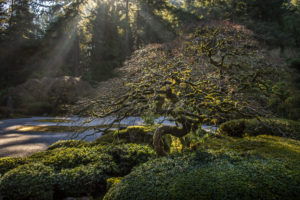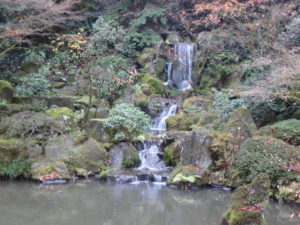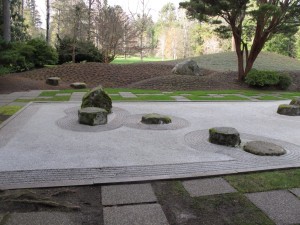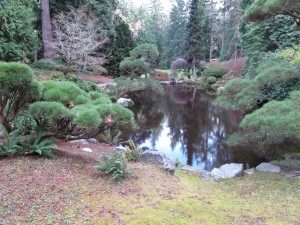The Japanese Garden of Portland, Oregon
Visiting a garden in winter allows me to see the bones of a garden, the internal structure which supports and enhances the flowers and leaves of the other three seasons. I like to go slowly through a winter garden to allow the spirit and essence of the garden to sink in. I recently visited the Japanese Garden of Portland, Oregon on a sunny, cold day. I left feeling calm and rejuvenated.
There are three main elements of a Japanese Garden. The first is stone, which provides a link to the mountains of Japan and provides a feeling of stability. The second is water, the life-giving force. For me, running water provides the music of a garden, which encourages tranquility. Quiet pools reflect sky and trees. Lastly, the plants of the garden provide the color and patterns that make each garden special. And of course, the trees in winter provide bones for the garden, along with the stone.
The Japanese Garden of Portland was conceived in 1961 as a way to promote cross-cultural understanding; it was first open to the public in 1967. It is one of the best examples of a Japanese garden outside of Japan, and is fully mature now, more than 50 years after the first plantings.
Of those original plantings, some of the most impressive are the Japanese red maples (Acer palmatum). These trees are planted throughout the garden, and many have been pruned to encourage lateral growth and are often in an umbrella shape.
Now is the best time to see those maples if you want to see their form, though the leaves are wonderful in spring, summer and fall. There are many with finely cut leaves in the garden, the ‘dissectum’ varieties. Unfortunately for me, the dissectum varieties are generally less hardy; many just to zone 6 (minus 10 degrees F in winter). The standard Japanese red maple is good to Zone 4 (minus 25 or 30), and the variety ‘Bloodgood’ is the hardiest of all. I have two, and I think every garden should have at least one.
Other trees at the Japanese Garden include Japanese red pine, Japanese black pine, azalea, rhododendron, ginkgo and various large firs, cedars and hemlock. There is an advantage to having evergreens in the garden, as they provide color – green – all winter.
There are two stone or gravel gardens in the Japanese Garden of Portland. In each of these there is a “sea” of gravel. That gravel is raked to create parallel ridges around the stones, mimicking waves in the sea. One has several large stones, representing mountains – but little else. In the main stone garden near the tea house there are also moss-covered islands and peninsulas in the gravel sea. I was told that the gravel in the bigger stone garden space was shipped from Japan.Stone lanterns are commonly placed on peninsulas in Japanese gravel gardens serving as lighthouses.
The Japanese Garden of Portland has streams, ponds and pools, all important elements for a Japanese garden. There is a wonderful hillside with a waterfall and a stream that feeds a pond. In the pond are koi; these resemble goldfish and can get to be quite large. Some are orange, others white, some spotted. Koi are the Labrador retrievers of the water: good looking and always looking for a handout.
I called senior gardener Adam Hart after I returned to New Hampshire to ask about flowers that bloom in the gardens in the warmer seasons. I was surprised that the gardens really do not have herbaceous perennials as part of the plant palette, with the exception of Japanese iris (Iris ensata).
Mr. Hart explained that although some of the trees bloom with colorful flowers, the plants installed should generally have 4 season interest – hence no primroses, peonies or other Japanese flowers. Just the iris, which are similar to our bearded iris, but the falls (outer petals) lie flat out, horizontally. The blossoms can be quite large, up to 6 inches across. I grow them, they are hardy to Zone 4,minus 30 in winter. They like wet soils, and will even grow in standing water. Fabulous plants. The iris are in bloom in June and July, so that would be an excellent time to visit.
For me, it is important that a Japanese garden is sparse, simple, and quiet. It should encourage a person to be reflective and have seating so one can relax and enjoy what the garden has to offer. It should have open spaces and lots of stone and gravel.
The Japanese Garden of Portland is open all year, so if you plan to go to Portland, schedule a visit. There is a discount for tickets purchased in advance, and for seniors or children. Visit the website, https://japanesegarden.org for more information.
Henry’s web site is www.Gardening-Guy.com. He is the author of 4 gardening books. You may reach him at henry.homeyer@comcast.net.
Japanese Gardens
I recently visited an old college friend in Seattle, Washington and while out there we went to some nice gardens in the area. The Bloedel Reserve is on Bainbridge Island, a 30 minute ferry ride from downtown Seattle. It is a private 150-acre estate that was once the summer home and gardens of a wealthy Seattle family. The founder’s vision was “to provide refreshment and tranquility in the presence of natural beauty,”; the Reserve’s mission is to “enrich people’s lives through a premier public garden of natural and designed Pacific Northwest landscapes.”In my opinion, it meets its goals well.
The best part of the Bloedel Reserve, for me, is the Japanese garden. I have visited several Japanese gardens, and this one is a fine example of the style. It includes a tea house, a dry garden, a small flowing brook that enters a nice pond, large stones, lovely trees and flowers in season. Although I don’t aspire to create a Japanese garden, I recognize that many of the elements that are so attractive in a Japanese garden can be utilized in my own garden – or perhaps yours.
On the surface, at least, the easiest part of the Japanese garden is the dry garden, also called the flat garden or hira-niwa. Generally in Japanese gardens this is a space without vegetation: raked sand or fine gravel that is interspersed with stones of various sizes and shapes. To me, the fine gravel represents the sea and the large stones in it, islands. Some Japanese gardens include trees on islands in the dry garden, but this one did not. At Bloedel Reserve, the shape of the dry garden was rectangular, though I have to say I prefer the curves of others I have seen – they seem more natural. It is traditional to rake the sand or gravel regularly to create interesting patterns in it.
If I were to create a dry garden, I would certainly install a weed barrier beneath the gravel. I wouldn’t use plain black plastic – as effective as it is in keeping out weeds – as it would hold water. There are a variety of woven weed barriers that allow moisture to pass through, although some grasses and weeds can send roots through them. It’s important to have the dry garden flat.
It would be essential to have some kind of edging to keep grasses from creeping into the dry garden. Plastic edging exists in various forms – rolls, sections that interlock – but I have never found them easy to install or very effective at keeping out grasses. I like the “professional” edging made of steel or aluminum that comes in 10-foot sections and is held in place with metal pegs. It generally comes with a black painted surface. It is quite flexible, allowing one to create smooth curves, and can be installed using an edging tool or spade to cut through sod. Stone pavers would also work nicely.
Traditionally there is a tea house that overlooks the dry garden, and Bloedel was no exception. This is a place to sit and reflect on the tranquility of the gardens. The tea house has large glass panels on the side facing the dry garden, which create a visual frame for the dry garden from inside.
There are also benches throughout the gardens where one can sit and observe or ponder the state of the world. I think sitting places are important for any garden, the more comfortable the better. I have two stone benches in my gardens, but rarely sit on them for long – the stone is hard and often cold. But wooden ones, or wooden chairs, are more comfortable. And now days brightly colored Adirondack chairs in recycled plastic are not only comfortable, they are inexpensive – but not very Japanese.
Water is an important element of a Japanese garden, and traditionally they have both streams and ponds. The technology exists to create re-circulating streams and waterfalls, or to install a nice small plastic-lined pool. Goldfish or koi are an important element to small manmade pools, as they help to keep the water clean. At Bloedel a dry stream was created using stones “flowing” down a hillside.
The vegetation of any Japanese garden is important, too. Japanese red maples (Acer palmatum), rhododendrons, cherry trees and various evergreens, (particularly weeping evergreens) are commonly used for vertical elements. Weeping red maples stay small and can be very effective in Japanese gardens, but often are not hardy in Zones 3 and 4.
At Bloedel the perennial plants were largely dormant in late November, but I recognized the leaves of hellebores, decorative grasses, ferns, mosses and groundcovers.
It’s good, I think, to dream of garden projects, especially in these dark days of December. And who knows? Maybe I’ll decide to create a small Japanese garden next summer – but if you do, let me know as I’d love to visit it.
Henry Homeyer can be reached at P.O. Box 364, Cornish Flat, NH 03746 or henry.homeyer@comcast.net. His Web site is www.Gardening-guy.com.







